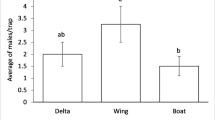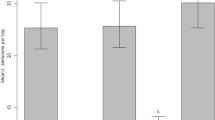Abstract
Observations and experiments covering a period of 3 years and using various techniques for attrapping the potato tuberworm moth in storages showed that water pans baited with impregnated rubber caps containing a mixture of 2 components were the best method for its detection. It was found that the moth exists during the whole year in the region of Casablanca. The sex pheromone traps demonstrated their value for early detection of infestations in storages.
Zusammenfassung
Die Untersuchung in den marokkanischen Kartoffelverpackungsstationen unter Einsatz von Testkisten und pheromonbeköderten Fallen zeigte, daß durch die ganzjährig im Freiland vorkommende Kartoffelmotte,Phthorimaea operculella Zell., ein Befall auch in den Stationen auftritt.
Pheromonfallen sind in hervorragender Weise geeignet, eine Lokalisierung und Früherkennung dieses Vorratsschädlings zu ermöglichen. Die Einfachheit ihrer Anwendung und das leichte Auswerten der selektiven Fänge, lassen Pheromonfallen als ideale Befallsindikatoren erscheinen.
Résumé
D'après les essais realisés dans les stations d'emballages et en plein champs sur l'utilisation des différentes méthodes de piégeage de la teigne de la pomme de terre, il s'est avéré que les pièges à phéromones ont donné les meìlleurs résultats pour la detection de la teigne. A l'aide de ce genre de piège il a été prouvé que la teigne de la pomme de terre se trouve pendant toutes les saisons de l'année sous les conditions métérologiques de Casablanca. En conclusion, l'utilisation des pièges à phéromone serait un moyen technique très utile pour la detection des infestations de la teigne aussi bien dans les stations d'emballage qu'en plein champs.
Similar content being viewed by others
Literaturverzeichnis
Bacon, O. G., Seiber, J. N., Kennedy, G. G., 1976: Evaluation of survey trapping techniques for potato tuberworm moths with chemical baited traps. Journ. econ. entomol.69, 5, 569–572.
Broodryk, S. W., 1971: Ecological investigations on the potato tuber moth. Phytophylactic3, 73–84.
Foot, M. A., 1974: Cultural practices in relation of potato crops by the potato tuber moth. N.Z.J. Exp. Agric.2, 447–450.
Haines, C. P., 1977: The potato tuber moth: a bibliography of recent literature. Rep. Trop. Inst., G112 iii+15.
Krambias, A., 1976: Climatic factors affecting the catches of potato tuber moth at a pheromon trap. Bull. ent. Res.,66, 81–85.
Levinson, H. Z., 1977: Lockstoffe als Insektistatika. Z. ang. Ent.84, 1–19.
Minks, A. K., 1975: Die mögliche Anwendung von Sexualpheromonen für die Bekämpfung des Apfelschalenwicklers im holländischen Obstbau. Z. ang. Ent.77, 3, 330 bis 336.
Passlow, T., Rossiter, P. D., 1973: Insecticides for the protection of stored potatoes. Queens. journ. Agric. anim. Scien.30, 151–155.
Reichmuth, C. H., Wohlgemuth, R., Levinson, A. R., Levinson, H. Z., 1976: Untersuchungen über den Einsatz von pheromonbeköderten Klebefallen zur Bekämpfung von Motten im Vorratsschutz. Z. ang. Ent.82, 95–102.
Persoons, C. J., Voerman, S., Verwiel, P. E. J., Ritter, F. J., Nooyen, W. J., Minks, A. K., 1976: Sex pheromone of the potato tuberworm moth: isolation, identification and field evaluation. Ent. exp. & appl.20, 289–300.
Roelofs, W. L., Kochansky, J. P., Carde, R. T., Kennedy, G. G., Labovitz, J. N., Corbin, V. L., 1975: Sex pheromone of the potato tuberworm moth. Life sciences17, 699–706.
Thal, J., 1977a: Massenauftreten der Kartoffelmotte in Marokko. Ges. Pflanz.29, 11, 277–278.
Thal, J., Taoudi, M., 1978 b: Les connaissances actuelles sur la teigne de la pomme de terre au Maroc. Bull. Protec. Cult., Rabat,3, 7–11.
Thal, J., 1978c: Zur Wirkung von Sexualpheromonen der Kartoffelmotte im Vergleich mit verschiedenen Lichtfallen. Anz. Schädlingskde., Pflanzenschutz, Umweltschutz51, 107–109.
Voerman, S., Minks, A. K., Persoons, C. J., 1976: Elucidation of the sex pheromone system of the potato tuberworm moth: a short review. Pot. Res.20, 123–126.
von Winning, E., 1941: Zur Biologie vonPhthorimaea operculella als Kartoffelschädling. Arb. physiol. ang. Entom.8, 112–128.
Author information
Authors and Affiliations
Additional information
Mit einer Abbildung und 3 Tabellen
Rights and permissions
About this article
Cite this article
Thal, J. Untersuchungen über das Vorkommen der Kartoffelmotte, Phthorimaea operculella Zeller (Lep., Gelechiidae), in Vorratslagern unter Verwendung von Pheromonfallen. Anz. Schadlingskde., Pflanzenschutz, Umweltschutz 52, 44–47 (1979). https://doi.org/10.1007/BF01903167
Issue Date:
DOI: https://doi.org/10.1007/BF01903167




